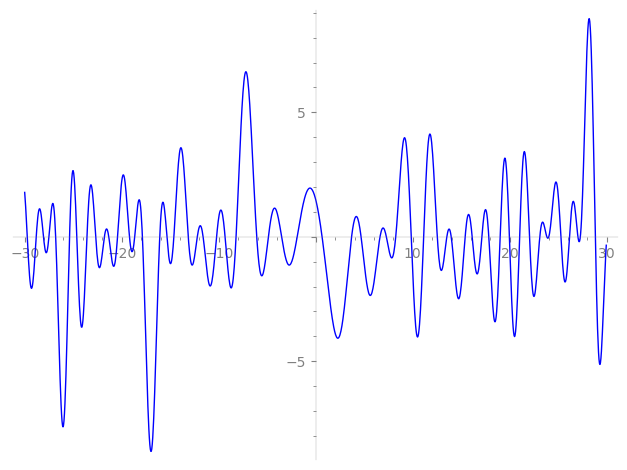| L(s) = 1 | + (1.55 − 3.68i)2-s + 3.76i·3-s + (−11.1 − 11.4i)4-s − 11.8·5-s + (13.8 + 5.84i)6-s + 89.5i·7-s + (−59.5 + 23.3i)8-s + 66.8·9-s + (−18.3 + 43.4i)10-s + 34.3i·11-s + (43.1 − 42.0i)12-s + 49.4·13-s + (329. + 139. i)14-s − 44.3i·15-s + (−6.71 + 255. i)16-s − 9.58·17-s + ⋯ |
| L(s) = 1 | + (0.388 − 0.921i)2-s + 0.418i·3-s + (−0.697 − 0.716i)4-s − 0.472·5-s + (0.385 + 0.162i)6-s + 1.82i·7-s + (−0.931 + 0.364i)8-s + 0.825·9-s + (−0.183 + 0.434i)10-s + 0.284i·11-s + (0.299 − 0.291i)12-s + 0.292·13-s + (1.68 + 0.710i)14-s − 0.197i·15-s + (−0.0262 + 0.999i)16-s − 0.0331·17-s + ⋯ |
\[\begin{aligned}\Lambda(s)=\mathstrut & 92 ^{s/2} \, \Gamma_{\C}(s) \, L(s)\cr =\mathstrut & (0.716 - 0.697i)\, \overline{\Lambda}(5-s) \end{aligned}\]
\[\begin{aligned}\Lambda(s)=\mathstrut & 92 ^{s/2} \, \Gamma_{\C}(s+2) \, L(s)\cr =\mathstrut & (0.716 - 0.697i)\, \overline{\Lambda}(1-s) \end{aligned}\]
Particular Values
| \(L(\frac{5}{2})\) |
\(\approx\) |
\(1.38229 + 0.561976i\) |
| \(L(\frac12)\) |
\(\approx\) |
\(1.38229 + 0.561976i\) |
| \(L(3)\) |
|
not available |
| \(L(1)\) |
|
not available |
\(L(s) = \displaystyle \prod_{p} F_p(p^{-s})^{-1} \)
| $p$ | $F_p(T)$ |
|---|
| bad | 2 | \( 1 + (-1.55 + 3.68i)T \) |
| 23 | \( 1 - 110. iT \) |
| good | 3 | \( 1 - 3.76iT - 81T^{2} \) |
| 5 | \( 1 + 11.8T + 625T^{2} \) |
| 7 | \( 1 - 89.5iT - 2.40e3T^{2} \) |
| 11 | \( 1 - 34.3iT - 1.46e4T^{2} \) |
| 13 | \( 1 - 49.4T + 2.85e4T^{2} \) |
| 17 | \( 1 + 9.58T + 8.35e4T^{2} \) |
| 19 | \( 1 - 448. iT - 1.30e5T^{2} \) |
| 29 | \( 1 - 569.T + 7.07e5T^{2} \) |
| 31 | \( 1 + 281. iT - 9.23e5T^{2} \) |
| 37 | \( 1 - 167.T + 1.87e6T^{2} \) |
| 41 | \( 1 + 1.75e3T + 2.82e6T^{2} \) |
| 43 | \( 1 - 2.15e3iT - 3.41e6T^{2} \) |
| 47 | \( 1 + 2.24e3iT - 4.87e6T^{2} \) |
| 53 | \( 1 + 2.32e3T + 7.89e6T^{2} \) |
| 59 | \( 1 - 329. iT - 1.21e7T^{2} \) |
| 61 | \( 1 - 3.99e3T + 1.38e7T^{2} \) |
| 67 | \( 1 - 3.64e3iT - 2.01e7T^{2} \) |
| 71 | \( 1 + 3.43e3iT - 2.54e7T^{2} \) |
| 73 | \( 1 - 6.32e3T + 2.83e7T^{2} \) |
| 79 | \( 1 + 1.13e4iT - 3.89e7T^{2} \) |
| 83 | \( 1 + 5.28e3iT - 4.74e7T^{2} \) |
| 89 | \( 1 - 1.22e4T + 6.27e7T^{2} \) |
| 97 | \( 1 + 7.38e3T + 8.85e7T^{2} \) |
| show more | |
| show less | |
\(L(s) = \displaystyle\prod_p \ \prod_{j=1}^{2} (1 - \alpha_{j,p}\, p^{-s})^{-1}\)
Imaginary part of the first few zeros on the critical line
−13.14013752827740680647263942506, −12.20748463856740580281055618366, −11.60861814178588278945037495182, −10.21966598100658418493551238613, −9.343508990215072022269556499890, −8.212521409064410822293119785598, −6.08016528108894758712507395481, −4.87860383377419209348547008052, −3.51658142924585274914538623060, −1.91091035229947916743605324383,
0.65606131887007219960037867448, 3.69624885498032537989631364376, 4.67476650450103173059396614530, 6.62747244813168866570070465431, 7.28109368351278153505034730643, 8.246720743384209231745571985529, 9.846038556135204490670202486760, 11.12451209558985342697856687018, 12.53251400496547791034975057792, 13.51450484820021155913276277100

